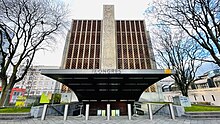|
Jozef Cantré Jozef Cantré (26 December 1890 – 29 August 1957) was a Belgian sculptor and illustrator. He was one of the main artists in the development of the movement of Flemish Expressionism. BiographyJozef Cantré was born in Ghent in 1890, four years after his brother Jan Frans. His father was a house painter.[1] He studied art at the Royal Academy of Fine Arts (Ghent), together with Frans Masereel; his teachers included Jean Delvin and Felix Metdepenningen.[1][2] He was politically active in a socialist youth movement and later created the "Rode Jeugd" ("Red Youth").[1] He studied Literature at the Vlaamsche Hoogeschool from 1916 on, together with the poet Richard Minne. Already in March 1918 he was appointed lector in drawing. His role in this university, created by the German occupier, led to his conviction in 1920, when he was sentenced to 5 years imprisonment. This sentence was removed in 1929.[1] On 27 October 1918, when it became clear that Germany would lose the war, Cantré fled the country.[1] He then lived in Blaricum until 1921 and then in Oisterwijk, both in the Netherlands, where he was joined by Frits Van den Berghe and Gustave de Smet. In 1930 he returned to Belgium where he moved to Sint-Martens-Latem, which would become the center of the Flemish art during the interbellum. By 1931 he lived in the nearby Astene, where Hubert Malfait became his neighbour. Afterwards he moved to Ghent. Between 1941 and 1946 he was a teacher at the La Cambre Art Institute.[2] He was married to Martha Vandaele; they had one son, Walter Cantré.[2] ArtHis early art is influenced by Georges Minne and Constantin Meunier. Later influences include fauvism, cubism and German Expressionism, before he became one of the founders of the so-called Flemish expressionism. He was one of the main avant-garde illustrators in Belgium between World War I and World War II as a member of De Vijf ("The Five") together with his brother Jan Frans Cantré, Joris Minne, Frans Masereel and Henri Van Straeten. Most of his graphic work consisted of engravings and woodcuts, as stand-alone works, ex-libris, or book illustrations.[3] As a sculptor, he worked in wood, clay and bronze. Together with Frits Van den Berghe and Gustave de Smet he is also considered one of the pioneers of the Flemish Expressionism,[3] and together with Oscar Jespers the main sculptor in the movement. Bibliography
Major sculptures 
Exposition
Notes
Further reading
|